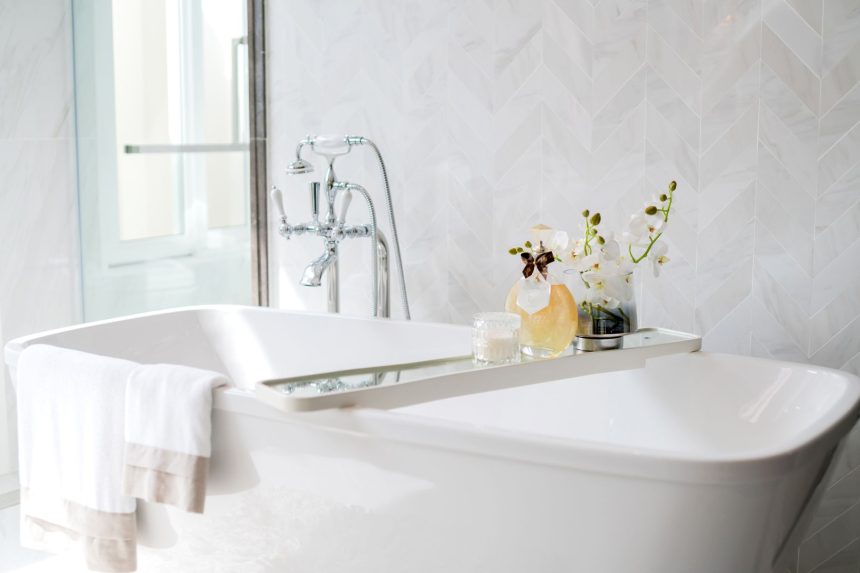When your interiors need a pick-me-up, one of the easiest and most affordable options is a fresh coat of paint. It’s generally a low-risk method: You aren’t permanently altering walls or investing in new furniture, and painting lets you play around with different colors.
While this approach is optimal for some spaces, not every part of the home is a good pick for paint. Take the bathroom—cabinets and walls hold up well with the right paint (choose a formula that’s long-lasting and resists humidity, such as a satin or gloss finish). However, according to the experts we spoke to, there are some things that you should never paint in the bathroom.
Backsplash
Getty / aire images
The sink area can quickly turn into a splash zone—especially if you have little ones around. While it might seem like a good idea to continue wall paint down to the counter, Kenna Stout, founder and principal of Brio Interior Design, cautions against it. “In a high-use family bathroom, I suggest avoiding a painted backsplash material—I typically opt for tile or slab backsplash,” she says.
In a less-used bath or a powder room, however, Stout gives the green light on paint. “Painted wainscoting could be a perfectly acceptable and durable choice,” she says. “You’ll want to work with your supplier or contractor to select the right paint product for the job.”
Floor Tile
Courtesy of Floor & Decor 2024 Trend Lookbook
Pause before taking a roller to the floor. Between the constant foot traffic and inevitable water drips, the wear-and-tear of everyday use will quickly deteriorate the varnish.
“The paint will eventually peel off, and you’ll end up with a much worse look than you started with!” says Negar Reihani, interior designer and founder of Space Harmony. Her alternative is slightly more labor-intensive, but the aesthetic payoff is worth it. She suggests pouring concrete over the tile and polishing it, creating an “industrial chic” look.
Wall Tile
John Keeble/Getty Images
Like its underfoot counterpart, wall tile is never a good candidate for painting—no matter how dated or worn it appears. “Although it might be tempting to save time and money, these surfaces will likely not hold up over time with exposure to moisture,” Stout says. “Try refinishing or restoring the materials with a trusted professional instead—especially if it’s not within your budget to demo and replace them with something new.”
Reihani agrees, noting that painted tile will likely look “crafty” rather than professional. Instead, she recommends trying the popular peel-and-stick tile in a fun pattern. “Keep in mind that they might not be the best solution for high-moisture areas like inside the shower,” she says. “But nor is a painted tile!”
Bathtub
Nataliia Sinchuk / GETTY IMAGES
As the focal point of many bathrooms, the tub might feel like a good piece to paint, but designers warn against this move. For starters, the slick surface is difficult for the paint to adhere to, and it will eventually peel and bubble, leaving the tub looking blotchy and worn.
“Don’t paint the exterior of a freestanding tub to add a punch to your bathroom,” Reihani says. “Instead, use wall decals! They come in thousands of designs, patterns, and colors that you simply stick on your surface. It’s an easy and unique alternative that can create a nice impact.”
Faucets and Fixtures
Gloria Sonda / 500px / GETTY IMAGES
Aside from creating a huge mess, painting faucets and fixtures could result in paint chipping into the sink, your evening glass of water, or your hands. If you’re looking for a punch of color, it’s a smarter (and safer) bet to choose hardware that’s already cast in the shade you desire.
Brands like Vola, Fantini, and Roca offer options in dozens of shapes and shades. No matter which direction you go in, though, Stout reiterates the importance of durability. “You’ll want to be sure you’re selecting finishes and materials that can withstand exposure to water and humidity,” she says.







